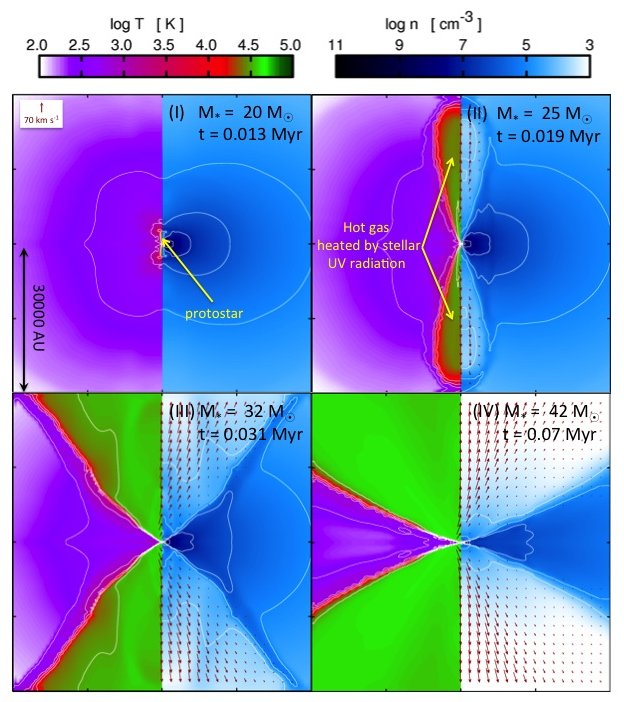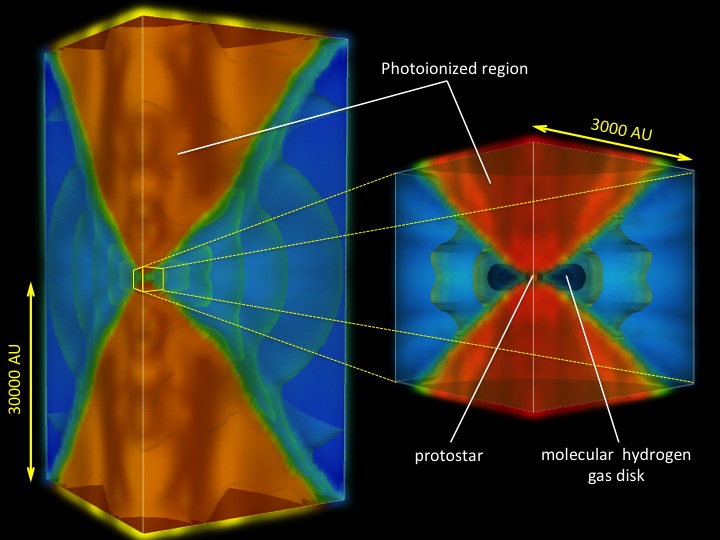An international research group including Naoki Yoshida at IPMU reported the result of a new computer simulation to show that the first stars in the universe were not monstrous scientists had believed.The team led by Takashi Hosokawa, a JSPS fellow at Kyoto University and NASA Jet Propulsion Laboratory, together with Kazuyuki Omukai at Kyoto University and Harold Yorke at NASA, performed a large-scale computer simulation of the formation and evolution of one of the first stars in the universe. The mind-boggling simulation took several weeks. At the end of the calculation, Hosokawa and his colleagues found the full grown star weighed about 40 times that of the Sun. They also discovered how such a primordial star regulated its own growth not to be extremely heavy.
The research article has been selected as one of the highest impact papers by the Science magazine and will be published as Science Express on November 11th.
It is widely believed that the first stars were formed when the age of the universe was a few hundred million years old. At its birth, a first star is just a tiny embryo ? a protostar ? with a mass of about one percent of the sun. The protostar is then expected to grow by accumulating the surrounding hot gas, but how much gas it can acquire has been largely unknown. The new research revealed the entire process of the star’s growth over a hundred thousand years until it became a real shining star through nuclear burning.
Astrophysicists thought so far that the first stars could grow huge, as much as a few hundred times the sun in mass. However the star regulates its own growth by emitting intensive radiation, according to the new study. The computer simulation showed highly dynamical features of this process. When the star became as large as 20 times that of the sun, it shined very bright, almost equivalent to a cluster of a hundred thousand of sun-like stars. Ultra-violet light from the luminous star then quickly heated up the gas in the vicinity to above ten thousand degrees in temperature. The hot bubble launched a high speed gas flow outward, which eventually evacuated the surrounding ‘parent’ gas cloud from which the star was born. There remained a star with a mass of 43 times that of the sun.
Such ordinary massive stars, in the sense there are indeed such stars with similar masses in the present-day Universe, finally resolve a long-standing problem of explaining the observed elemental abundances of very old stars in our Galaxy.
The four researchers now successfully propose a novel theoretical model of the evolution of the universe at its infancy.
________________________________________
Publication: Sciecnce (Science Express)
Title:Protostellar Feedback Halts the Growth of the First Stars in the Universe
Authors:
Takashi Hosokawa (JSPS fellow/Kyoto University・NASA Jet Propulsion Laboratory (JPL))
Kazuyuki Omukai(Associate Professor/Kyoto University)
Naoki Yoshida(Associate Professor/Institute for the Physics and Mathematics of the universe
(IPMU))
Harold W. York (NASA Jet Propulsion Laboratory (JPL))
________________________________________
|
Figure1: The growth of a first star |
|
|
Figure2: A 3-D view of the star and the surrounding gas. |
*More pictures are available on the Reference. |
________________________________________
Reference:
http://www-tap.scphys.kyoto-u.ac.jp/~hosokawa/firststars.html
________________________________________
Science Contact:
Kazuyuki Omukai(Associate Professor/Kyoto University Graduate School of Science)
E-mail: omukai@tap.scphys.kyoto-u.ac.jp
Tel: +81-75-753-3840
Media Contact:
Fusae Miyazoe / Tomomi Hijikata (Press officer, IPMU)
E-mail: press@ipmu.jp
Tel: +81-4-7136-5977








